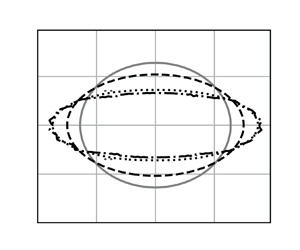Published online by Cambridge University Press: 28 February 2022

Many recent studies have diagnosed opposite-signed diffusion eigenvalues to be a prevalent feature of the transfer tensor for diffusive tracer transport by oceanic mesoscale eddies. This diagnosed tensor, which we refer to as the diffusion tensor, therefore accounts for tracer filamentation effects. The preferential orientation of this filamentation is quantified by the principal axis of the diffusion tensor, namely the diffusion axis. Parameterisations of eddy diffusion commonly invoke a diffusion tensor, typically one with non-negative eigenvalues to avoid numerical issues. Motivated by the need to parameterise tracer filamentation, in this study we examine diffusion of a Gaussian tracer patch with imposed opposite-signed diffusion eigenvalues, and in particular we focus on the time scale for the onset of instability. For a fixed diffusion axis, numerical instability is an inevitable consequence of persistent up-gradient fluxes associated with the negative eigenvalue. For typical oceanic scales and diffusion magnitudes, this time scale is of the order of  $100$ days, but is shorter for larger negative eigenvalues or for finer grid resolutions. We show that imposing a time-dependent diffusion axis can lead to simulations with no onset of instability after 100 000 days of tracer evolution. Although motivated by oceanographic fluid dynamics, our results have much broader applications since diffusive processes are present in a wide range of fluid flows.
$100$ days, but is shorter for larger negative eigenvalues or for finer grid resolutions. We show that imposing a time-dependent diffusion axis can lead to simulations with no onset of instability after 100 000 days of tracer evolution. Although motivated by oceanographic fluid dynamics, our results have much broader applications since diffusive processes are present in a wide range of fluid flows.